Go to LARIMAR Products
Larimar is the Trade Name for blue Pectolite,
a beautiful gemstone which is only found in one location on Earth.
Larimar Is found in the south western mountainous area of the
Dominican Republic on the Island of Hispanola in the Caribbean.
PECTOLITE is a white to grey sodium, calcium hydroxite inosilicate
with a chemical composition of
NaCa2Si3O8(OH)
It has a hardness of 4.5 - 5 on Mohs scale and a specific gravity of 2.7 - 2.9.
Pectolite was first described in 1828 at Mt. Baldo, Trento Province. Italy.
It occurs as a primary mineral in nepheline syenites, within hydrothermal cavities
in basalts. It is often Found associated with zeolites, prehnite, calcite and serpentine.
Larimar Is found in the south western mountainous area of the Dominican
Republic on the Island of Hispanola in the Caribbean. The mines are located
in a volcanic area about 7 Kms away from the ocean and the Bahocuco River
sometimes washes small nodules of Larimar down from the mountains
where they are deposited on the beaches near the city of Barahona.
In 1916, the then parish priest of Barahona, Miguel Domingo Fuertes de Loren,
informed on a blue-stone discovery and requested the permission to excavate the land,
but no one paid any attention to him.
In 1974 nodules of larimar were discovered by a Peace Corps volunteer who
showed them to local geologist Miguel Mendez. Mendez named it after his
daughter Larissa, + mar (Spanish for sea) = Larissa s gem from the sea.
He realised that the nodules weren t washed up from the ocean but was
washed down from the hills. Mendez tracked the material back to the source.
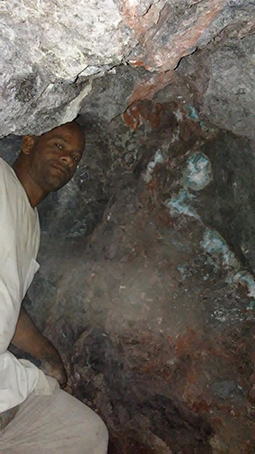
Fig. 1 Larimar In Basalt
The material occurs in a dark igneous rock in the form of nodules, some of them tube-like.
People have speculated that the tubes are logs that were engulfed by the lava flow and
then burned away by the volcanics leaving shaped openings.
<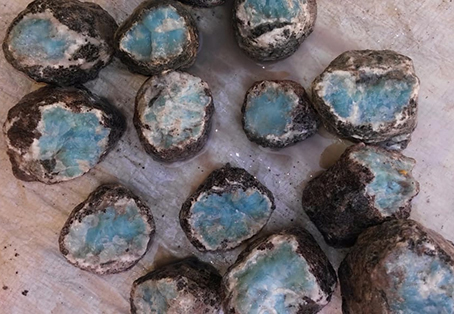 >
>
Fig. 2 Larimar Nodules
The material was later sent to the Smithsonian for identification and was
correctly identified as Pectolite. Mineralogists at the Smithsonian had never
seen blue pectolite before and speculated that it was a synthetic or a
furnace product of some kind.
My friend, Joel Arem, a leading US based Gemologist, who was working at
the Smithsonian at the time, was contacted by Steve Sloan, a man in his
twenties, who was living on the Island. His father was an Export Vice
President for Goodyear Tyres in the Caribbean and had a keen interest in stones.
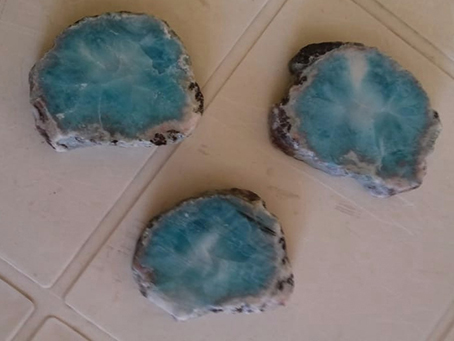
Fig. 3 Larimar Sliced Nodules
He had visited the mountain locality where the material was being
recovered in-situ on a small scale, and cut and sold in the tourist shops. and
insisted that the larimar was natural, Nobody believed him so he contacted
Joel Arem and invited him, as a gemologist, to visit the locality. Joel visited
the location in 1974 and was the first Gemologist to see the material on site
in the rocks and watched the men dig out the nodules. Joel agreed that the
material was indeed natural and collected a lot of geological samples (many
of which he has to this day) confirming that the Larimar was clearly filling
cracks and veins.
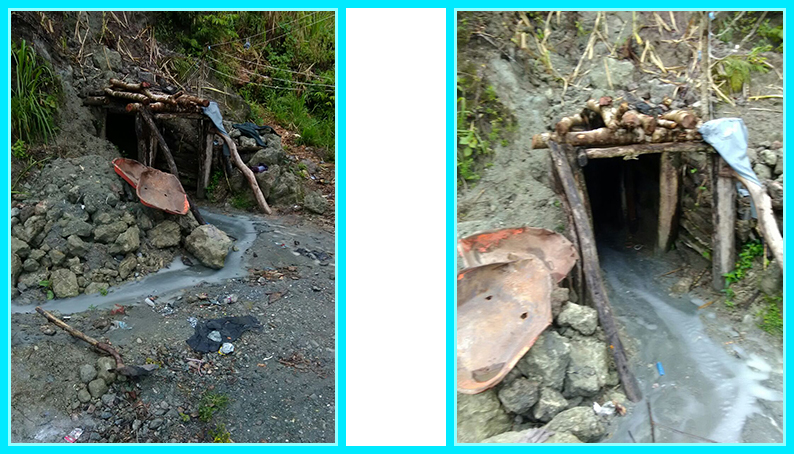
Fig. 4 Larimar Mine Adit
The most important outcrop of blue pectolite is located at Los Chupaderos in
the section of Los Checheses, about 10 km (6.2 mi) southwest of the city of
Barahona in the southwestern region of the Dominican Republic. It is a single
mountainside now perforated with approximately 2,000 vertical shafts,
surrounded by rainforest vegetation and deposits of blue coloured mine tailings.
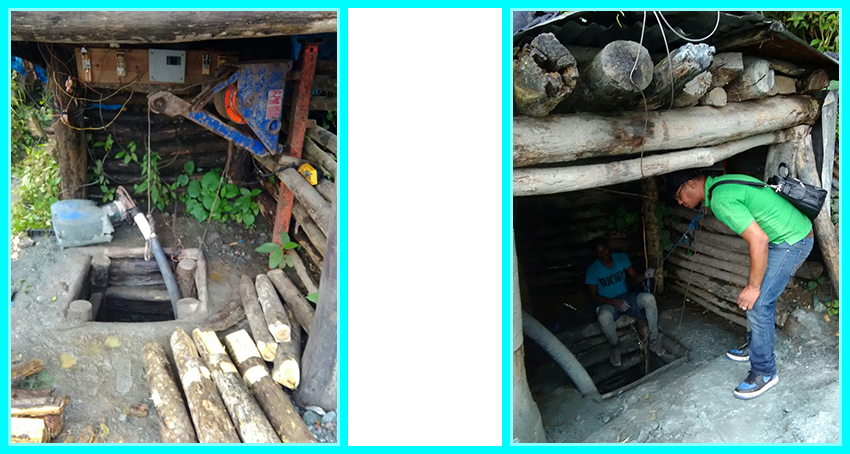
Fig. 5 Larimar Mine Shaft
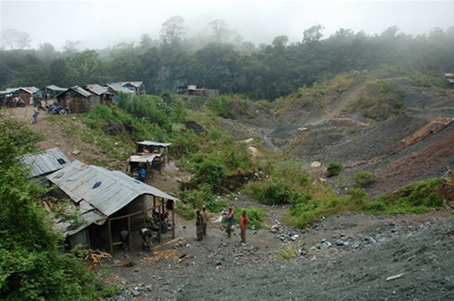
Fig. 6 Larimar Mines
Dominica gets 55 inches of rain a year and the area also has Eocene and
Miocene limestones (the volcanics are metamorphosed Mesozoic rocks –
there is even serpentine in the middle of the metamorphic complex).

Fig. 7 Larimar Slices
Water trickles through the volcanics (Joel witnessed it actually running like
a river down the veins) where it picks up silica and copper. There is plenty
of calcium around to contribute to the formation of pectolite with copper
as an impurity. The mineralogy of the veins and nodules is pectolite
+ calcite and some quartz mixed in as well that indurates everything
and provides hardness.
After more than 40 years the hillside deposit was long ago depleted and
apparently they are extensively mining underground - it became quite a big
deal! The mountainous terrain and wet climate make for extremely
dangerous mining conditions and currently mining is being carried out up to
90 metres (approximately 250 feet) underground in shafts and admits dug with
picks and shovels. Larimar is becoming increasingly more difficult to obtain
and natural, rough samples, are subject to export scrutiny from the island.
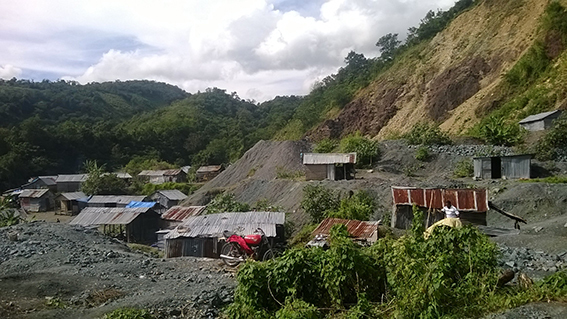
Fig. 8 Larimar Mines On Hillside
The miners enter the mountains through adits to access the shafts they
have dug by hand. The mines are wet and claustrophobic but the miners
will work for up to 9 hours a day in search of this beautiful blue gemstone.
If they are lucky they may find the dark blue material which is highly prized
and commands the highest price.
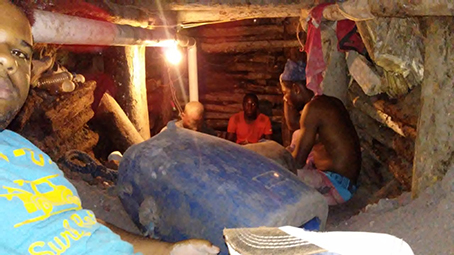
Fig. 9 Miners Underground
Larimar is coloured by copper. It occurs in Sky Blue, often with White
Veining and also Green and sometimes with Red inclusions.
Just like every gemstone quality dictates the value. Larimar has so
many patterns and colour ranges that can sell for several dollars a carat for the best gems.
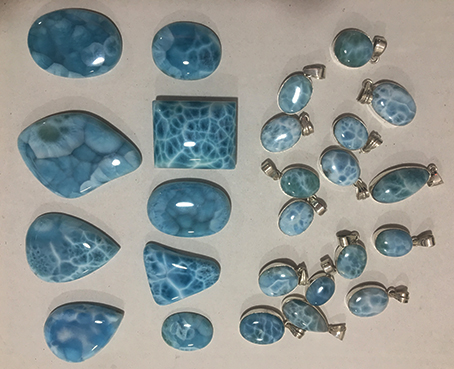
Fig 10 Larimar Pendants and Cabochons
Fig. 10 is a selection of larimar cabochons and pendants that we have in
stock. The jewellery is made in Dominican Republic so these are
directly from the source.
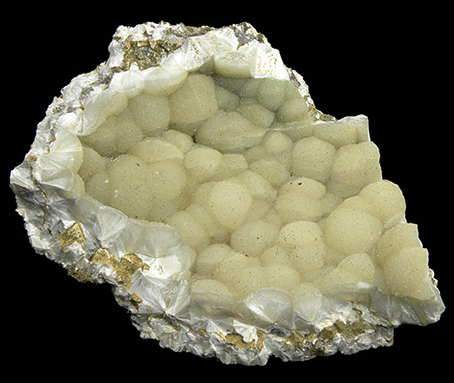
Fig. 11 Pectolite
Pectolite is a fibrous mineral that usually occurs in balls of radiating fibres
or hemispheres in cavities in basalt. The radiating fibrous structure can be
observed in Larimar and this is what creates the beautiful patterns.
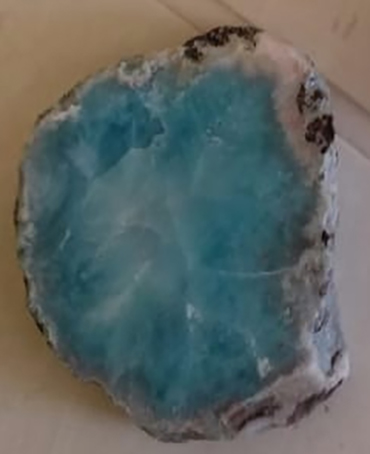
Fig. 12 Larimar Sliced nodule
The nodules it forms in are obviously vesicles in the volcanics, like you see
everywhere filled with agate, prehnite, amethyst geodes (Brazil) or
whatever, and the minerals being deposited fill whatever cracks are
available as well. It is not all just nodules.
I would like to sincerely thank my friend, Joel Arem, for his contribution
and also acknowledge Wikipedia which was extremely helpful in my research.
Back To Mineral Specimen Gallery
Are
you looking for clear boxes
for displaying and protecting your
favourite minerals, gems, fossils, meteorites or other collectibles.
We also make mineral
display stands and acrylic blocks.
CHECK
OUT THE
FOLLOWING LINK BELOW:
MINERAL
BOXES
And DISPLAY PRODUCTS
|
© Copyright, Gerald Reginald Pauley 2018
Back To Mineral Specimen Gallery
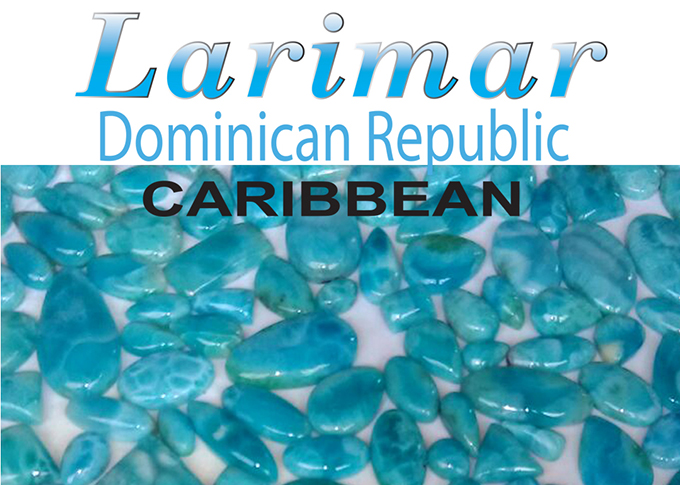

 >
>









